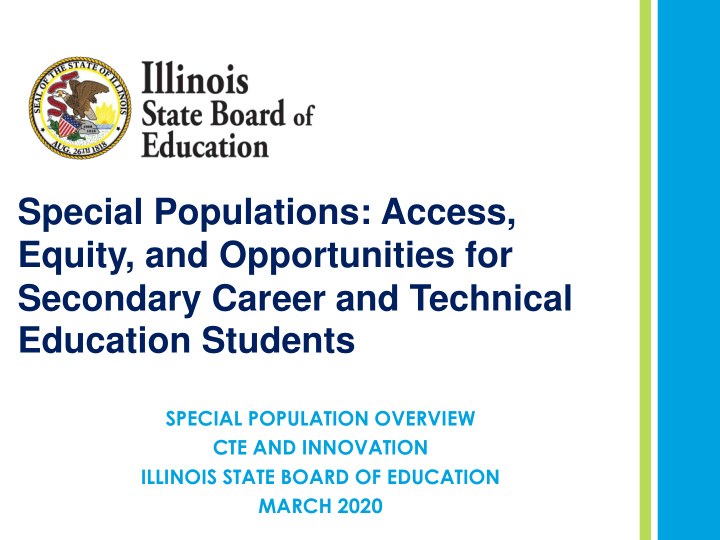



Special Populations: Access, Equity, and Opportunities for Secondary Career and Technical Education Students 2020 IACTE Conference SPECIAL POPULATION OVERVIEW CTE AND INNOVATION ILLINOIS STATE BOARD OF EDUCATION MARCH 2020 Illinois State Board of Education
All students; each and every student . . . deserves skill attainment through quality career and technical education programs of study. deserves equitable access and opportunities.
Equality =Sameness Equity =Fairness
Provide educational equity in policies, practices, and programs necessary to Reduce the predictability of who succeeds and who fails Interrupt reproductive practices that negatively impact diverse students in public, charter, and independent school settings Cultivate the unique gifts and talents of every student Provide opportunities that eliminate discrimination and denial of services on the basis of race, color, national origin, sex, and disability National Equity Project Vocational Education Programs Guidelines for Eliminating Discrimination and Denial of Services on the Basis of Race, Color, National Origin, Sex and Handicap
Objectives of the Presentation: Identify key elements of access and equity Identify changes to the special population groups as described by legislation Explore potential barriers for CTE concentrators Review changes with Perkins V Connect the LNA/CLNA and the Local Application Learn how Perkins V supports the success of students in CTE programs and possible resources Next Steps
Special Populations — Perkins V Individuals with disabilities Individuals from economically disadvantaged families, including low-income youth and adults Youth, who are in, or have aged out of, the foster care system Individuals preparing for nontraditional fields Single parents, including single pregnant women Out-of-workforce individuals (replaced displaced homemakers) English learners (replaced individuals with limited English proficiency Homeless individuals Youth with a parent who is a member of the armed forces and is on active duty
What barriers are your schools/students currently experiencing that may be impacting equitable access and/or student academic or technical skill obtainment for all students?
The Equity Provisions in Perkins V… Required * Identify equitable participation and performance gaps --- (LNA/CLNA/Continuous Cycle of Improvement) *reporting core indicators by gender, race, and special populations *Develop programing that remedies any areas of deficiency *use of funds (targeted) to meet the needs of special populations — decrease barriers *use of funds for career exploration and awareness
Equity Provisions continued Expectation of intentionality students are able to have access to programming Remove barriers maintain challenges/course expectations guidance/ supports
Accountability: Continuous Quality Improvement continual progress toward improving access and performance for all CTE students, including racial and ethnic subgroups, as well as special populations.
Comprehensive Local Local Application Needs Assessment Development
Local Application: Develop SMART Goals – 4 year plan • Needs of special populations, including equal access /nondiscrimination Local application includes . . . • Address disparities and gaps in performance • Preparation for nontraditional fields
Local Funding Implementation of strategies to improve student achievement and close gaps; Opportunities for educators – advance knowledge, skills, and evidenced-based practices; Training to provide appropriate accommodations Training related in frameworks to effectively teach students: Students with disabilities and English learners, which may include Universal design for learning; Multi-tier systems of supports (RTI); and Positive behavioral interventions and supports (PBIS). Other innovative means to increase student achievement/decrease barriers
Local Funding Activities that advance knowledge of career opportunities and assist students in making informed decisions about future education and employment goals, including non-traditional fields Supporting programs and activities that increase access, student engagement/success for students who are members of groups underrepresented fields: science, technology, engineering, and mathematics field (including computer science and architecture)
Local Funding Instructional content widely available, i.e. open educational resources Reduce/eliminate out-of-pocket expenses for special populations dual or concurrent enrollment program/early college high school programs, cost associated with fees, transportation, mobility challenges for special populations, other other barriers
CTE Best Practices Backward Design Lesson Planning Cornell Notes Bell ringer activities Super Strategies: Posted on ISBE.net/cte Entry and exit slips Inside/Outside Circles Instructional Strategies: Games/apps Prime the Brain (Clear learning objectives) Writing across the curriculum Think, pair, share Learning logs Gallery walks; Blended learning Rotating stations Team Leaders/Captains ABC Brainstorm Self-Reflection/Assessment Sketching/mind mapping Student-designed Learning Opportunities Graphic Organizers Integration of Core Academics 3-2-1 Response (reading, writing, math, etc.)
Multi-tiered Approaches RTI/PBIS
Universal Design for Learning (UDL) Process of designing instruction that is accessible by all students; (lessons designed with variability) multiple means of representation; multiple means of expression; and multiple means of engagement. https://bit.ly/3bfAKPx
Accountability and Data Transparency Expectations States and local recipients must: Report annually on core performance indicators for all students, disaggregated subgroup/special population, by career cluster Identify and quantify any disparities or gaps in performance As applicable, develop program improvement plans to remedy areas of identified deficiency
Program Improvement: Continuous Cycle of Improvement Model winter/spring of 2021 Collect Disaggregated Data Data Analysis Plan and and Review Implement Determine Determine Root Causes Identify Root Gaps Causes See “How to Conduct a Gap Analysis” at https://napequity.org/wp -content/uploads/NAPE-Perkins-V-State- Equity-Gap-Analysis-At-A-Glance_Updated_4-3-19_ml_bw.pdf
Resources isbe.net/cte (scroll to bottom of the page and locate the section “Equity, Access, and Special Populations” https://www.rti.org/impact/national-center-innovation-career-and-technical-education-ncicte https://www.clasp.org/sites/default/files/publications/2019/10/2019%20Perkins%20V%20State%20Plan%20Guida nce.pdf http://udloncampus.cast.org/page/planning_landing#.VO3gkrP2OuC Alliance for Excellent Education-https://all4ed.org/wp-content/uploads/2019/09/Perkins-CTE-Special- Populations_FINAL.pdf https://gtlcenter.org/learning-hub/equitable-access-toolkit/moving-toward-equity/what-is-equitable-access Perkins Collaborative Resource Network https://cte.ed.gov/ Super Strategies https://icsps.illinoisstate.edu/2016/10/special-population-recruitment-and-retention-support- strategies-documents/ Universal Design for Learning (UDL) www.cast.org https://napequity.org/wp-content/uploads/NAPE-Perkins-V-State-Equity-Gap-Analysis-At-A-Glance_Updated_4-3- 19_ml_bw.pdf Tennessee Leaders for Equity Playbookhttps://www.tn.gov/content/dam/tn/education/reports/Tennessee-Leaders- for-Equity-Playbook.pdf
Recommend
More recommend